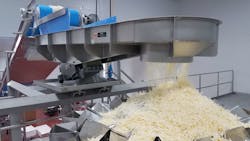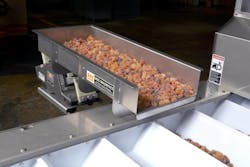Selecting electromagnetic vibratory feeders for food applications
The food production industry is continually growing, and automation is playing a significant role in increasing production and reducing costs. Challenges in conveying and processing food ingredients are widespread, depending on the size, shape, quantity, weight and texture of any given product, whether pasta, sausages, tomatoes, cheese, potatoes or any type of produce.
Automation in food processing involves extremely stringent sanitation standards that require accessible and easily dismantled components for cleaning. To preserve productivity, equipment must be capable of being sanitized and placed back in operation as quickly as possible without affecting the quality and integrity of the food product.
This is where modern vibratory feeding equipment comes into play. A variety of feeder models can efficiently handle a broad range of food products, including fine powders, tacky and granular materials, and bulk products. Vibratory feeders are also used to add ingredients to mixers and blenders before metering into downstream process equipment, screening oversized or fine materials from final products, and sprinkling salt, sugar, or various seasonings.
Equipment manufacturers continue to advance the design of vibratory feeders to meet the food industry’s challenges and satisfy guidelines for Safe Quality Foods (SQF), Good Manufacturing Practices (GMP) and other sanitation requirements. Government policies and industry standards also require that equipment installed in food processing facilities meet construction specifications outlined in programs such as company-implemented Hazard Analysis Critical Control Points (HACCP), the Food Safety Modernization Act (FSMA) and the Global Food Safety Initiative (GFSI).
Performing multiple jobs with feeders
Vibratory feeders are designed with varying amplitudes, frequencies and angles of deflection to effectively move assorted materials at specific rates. Individual designs are determined by many factors, including the food material being processed, the flow rate of the process, the nature of the environment, the frequency of needed starts and stops of the process, the cost to operate the equipment and the likelihood of repairs.
For example, the Eriez HS (High Speed) line of feeders is ideal for applications that necessitate fast travel speeds and frequent starts and stops. Other low-amplitude, high-frequency feeders are the right choice for handling free-flowing materials that have bulk densities above 20 pounds per cubic foot. Electromagnetic feeders under a hopper allow for a controlled supply of bulk ingredients to blenders, mixers, bucket elevators and belt conveyors.
Vibratory feeders are also used to move food groups out of storage and into the processing facility. A good example of this is nuts harvested in massive quantities, such as pistachios, almonds or peanuts. Feeders placed under large silos meter out nuts at precise rates for conveying downstream into bucket elevators. On the other end of production, vibratory feeders are incorporated to meter nuts onto scale systems for packaging.
Simple feeder tray construction is essential for vibratory feeders used in food industry settings. With no complex geometric barriers, the tray interior can be easily and quickly wiped down or washed out for product changeover or sanitation procedures. If screens or tray covers are required, these pieces can be designed for quick removal using fasteners that do not require tools.
Choosing the right feeder by food type
High-amplitude/low-frequency feeders are a good solution for handling light and bulky, fine powdery, and flexible products, including cereal, flaky and powdery spices, potato chips, raisins, candy and more. These units are the preferred option for adding a screening function to the conveying process.
In applications where the food product is composed of fine, leafy material, such as parsley flakes, a high-displacement, high-stroke type feeder is needed. High-deflection feeders are effective in these applications because the feeder combines the higher deflection necessary to convey these more difficult products with the maintenance-free service of an electromagnetic feeder.
Food items that have a tacky or gummy consistency, such as gummy candies and vitamins, also present unique challenges. These food types have a high coefficient of friction, making handling difficult because the product tends to adhere to conveyors and other equipment that moves food along the processing line. Sticky food products can cling to a conveyor belt and may not be released at the appropriate time. In these situations, product distribution is slowed or even stopped.
Electromagnetic feeders feature a totally enclosed magnetic drive to generate the vibratory action and enable feeding of practically any bulk material, from micron sized powders to bulky chunks. Eriez HD high deflection feeders, for example, feature feed rates of up to 60 feet per minute (18 meters per minute) and throughputs ranging from 150 to 700 cubic feet per hour.
Electromagnetic scarf plate or bias discharge feeders can sprinkle granular materials such as salt, sugar and seasoning onto snack foods or baked goods traveling on a wide belt conveyor, ensuring consistent coating of the product. Adding a hopper above an electromagnetic feeder allows this equipment to work in conjunction with weigh scales, batch operations and/or operations where additive feeding is performed either continuously or intermittently.
Processors also use electromagnetic feeders to deposit loose sprinkles onto candy or meter ingredients, such as chocolate bits, nuts or other inclusions, into ice cream. This type of application requires a feeder with a low profile and excellent metering capabilities, such as the Eriez Model C, which fits easily underneath a hopper and precisely handles feed rates from a spoonful to many tons of granular material per hour.
Customizable tray designs
The shape, length and width options for feeder trays are practically limitless. Food processors can order trays with features to satisfy their exact processing requirements. Every configuration of flat, curved, v-channel and tubular designs is available. Trays are typically fabricated from stainless steel for food applications. Trays that include a tray cover or screen deck generally feature toolless, quick-release fasteners to facilitate cleaning.
Technology advances make electromagnetic vibratory feeding solutions more useful than ever in food industry environments. Sanitary construction, easy cleaning, minimal maintenance requirements and cutting-edge designs ensure that these units are appropriate for facilities where product purity, energy cost savings, decreased equipment maintenance expenses and streamlined manufacturing operations are high priorities.
Case study: California Gold Almonds
Almost 80% of the world’s almonds are produced in California, so it is not surprising that California Gold Almonds (CGA) is using state-of-the-art operational procedures and innovative equipment technology to harvest and handle this increasingly popular cash crop.
CGA maintains processing efficiency with the assistance of a series of Eriez 66C and 46C electromagnetic feeders, which are installed at the company’s Tenaya and El Roya processing plants in Modesto, California, in the lush San Joaquin Valley. The feeders help reduce human touching and handling of the almonds while seamlessly conveying raw almonds to downstream equipment.
While located just a quarter mile from each other, the Tenaya and El Roya facilities each serve a different customer base. The 35,000-square-foot Tenaya facility processes almonds for domestic customers, while the 84,000-square-foot El Roya plant fulfills the company’s export business.
At the Tenaya facility, incoming raw almonds fall freely through a series of Eriez Model FF metal separators that effectively detect all magnetic and non-magnetic metal contamination, even if it is embedded in the almonds. Next, the Eriez 66C and 46C electromagnetic feeders convey a precise amount of raw almonds — approximately 12,000 pounds per hour — that eventually pass through an optical sorting line in the packaging process.
At the El Roya plant, two Model FF metal separators and several rare earth plates and tube magnets detect and remove contamination from the almonds. This Eriez equipment — along with a series of 66C and 46C electromagnetic feeders — is installed on the main processing line conveying 20,000 pounds of almonds per hour and a secondary line conveying 15,000 pounds per hour.
The Eriez feeders and other vital operational equipment help CGA meet rigid food safety guidelines, especially with the USDA, FDA and British Retail Consortium (BRC), since the company exports almost half of its total volume to European customers.
Rob Yandrick is global product manager — vibratory at Eriez. He is responsible for all aspects of global vibratory product management, including R&D interaction for new product development, global sales support for new and existing products, product line review for profitability and potential obsolescence opportunities, and overall global sales support. Rob joined Eriez in 2005 as manager of market development — vibratory/screening in the USA sales department.
Eriez
About the Author

Rob Yandrick
Global product manager — vibratory at Eriez
Rob Yandrick is global product manager — vibratory at Eriez. He is responsible for all aspects of global vibratory product management, including R&D interaction for new product development, global sales support for new and existing products, product line review for profitability and potential obsolescence opportunities, and overall global sales support. Rob joined Eriez in 2005 as manager of market development — vibratory/screening in the USA sales department.

